ANGLE BISECTOR THEOREM PROOF
Subscribe to our ▶️ YouTube channel 🔴 for the latest videos, updates, and tips.
Theorem
The internal (external) bisector of an angle of a triangle divides the opposite side internally (externally) in the ratio of the corresponding sides containing the angle.
Case (i) (Internally) :
Given : In ΔABC, AD is the internal bisector of ∠BAC which meets BC at D.
To prove : BD/DC = AB/AC.
Construction : Draw CE ∥ DA to meet BA produced at E.
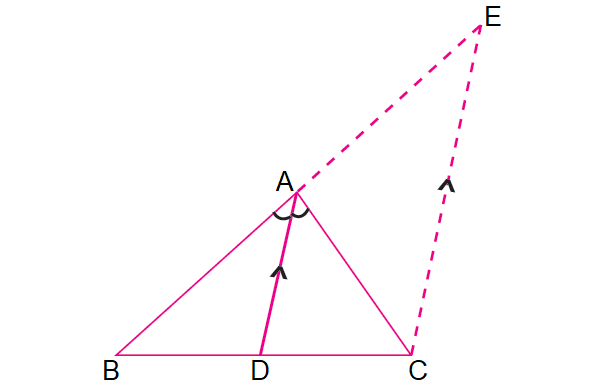
Proof (Internally)
Because CE ∥ DA and AC is the transversal, we have
∠DAC = ∠ACE (alternate angles) -----(1)
and
∠BAD = ∠AEC (corresponding angles) -----(2)
Because AD is the angle bisector of ∠A,
∠BAD = ∠DAC -----(3)
From (1), (2) and (3), we have
∠ACE = ∠AEC
Thus in ΔACE, we have
AE = AC
(Sides opposite to equal angles are equal)
Now, in ΔBCE we have, CE ∥ DA.
By Thales Theorem,
BD/DC = BA/AE
Because AE = AC,
BD/DC = AB/AC
Hence the theorem.
Case (i) (Externally) :
Given : In ΔABC, AD is the external bisector of ∠BAC and intersects BC produced at D.
To prove : BD/DC = AB/AC.
Construction : Draw CE ∥ DA meeting AB at E.
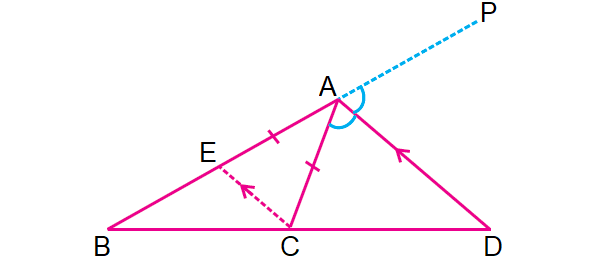
Proof (Externally)
Because CE ∥ DA and AC is a transversal, we have
∠ECA = ∠CAD (alternate angles) ----(1)
Also, CE ∥ DA and BP is a transversal, we have
∠CEA = ∠DAP (corresponding angles) ----(2)
But AD is the bisector of ∠CAP,
∠CAD = ∠DAP ----(3)
From (1), (2) and (3), we have
∠CEA = ∠ECA
(Sides opposite to equal angles are equal)
In ΔBDA, we have EC ∥ AD.
By Thales Theorem,
BD/DC = BA/AE
Because AE = AC,
BD/DC = BA/AC
Hence the theorem.
Solved Problems
Problem 1 :
In the ΔABC shown below, find the length of AD.

Solution :
Since CD is the angle bisector of ∠C, by Angle Bisector Theorem,
AD/DB = CA/CB
Substitute.
AD/6 = 4/8
AD/6 = 1/2
Multiply both sides by 6.
AD = 3
Problem 2 :
In the ΔABC shown below, find the length of CD.
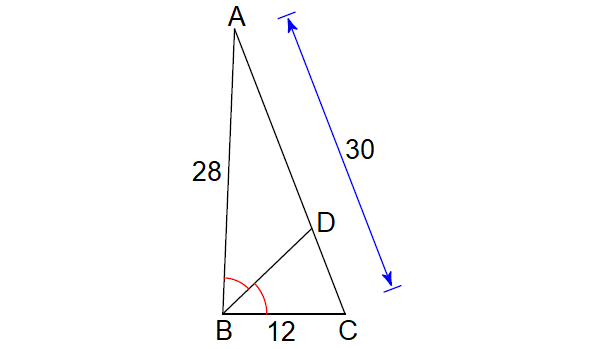
Solution :
Let x be the length of CD.
Then the length of DA = 30 - x.
Since BD is the angle bisector of ∠B, by Angle Bisector Theorem,
CD/DA = BC/BA
Substitute.
x/(30 - x) = 12/28
x/(30 - x) = 3/7
7x = 3(30 - x)
7x = 90 - 3x
Add 3x to each side.
10x = 90
Divide each side by 10.
x = 9
CD = 9
Problem 3 :
Solve for x.
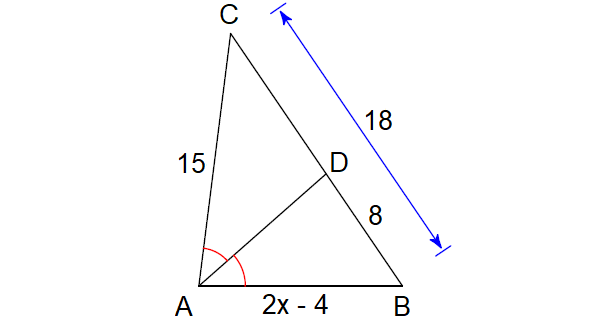
Solution :
Find the length of DC :
DC = BC - DC
= 18 - 8
= 10
Since AD is the angle bisector of ∠A, by Angle Bisector Theorem,
BD/DC = AB/AC
Substitute.
8/10 = (2x - 4)/15
4/5 = (2x - 4)/15
15(4) = 5(2x - 4)
60 = 10x - 20
Add 20 to each side of the equation.
80 = 10x
Divide each side by 10.
8 = x
Problem 4 :
Solve for x.
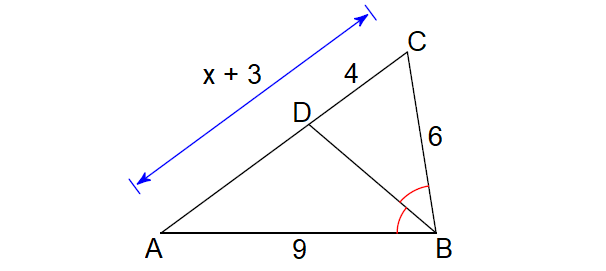
Solution :
Find the length of DA :
DA = CA - Cd
= (x + 3) - 4
= x + 3 - 4
= x - 1
Since BD is the angle bisector of ∠B, by Angle Bisector Theorem,
CD/DA = BC/BA
Substitute.
4/(x - 1) = 6/9
4/(x - 1) = 2/3
3(4) = 2(x - 1)
12 = 2x - 2
Add 2 to each side.
14 = 2x
Divide each side by 2.
7 = x
Problem 5 :
In the given figure, AD is the bisector of <BAC, if AB = 10 cm, AC = 6 cm and BC = 12 cm. Find BD and DC.
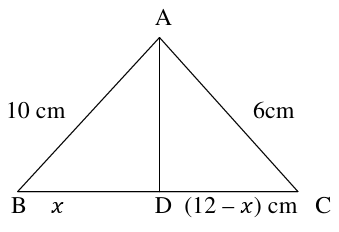
Solution :
BD = x, DC = 12 - x, AB = 10 cm and AC = 6 cm
BD/DC = AB/AC
x/(12 - x) = 10/6
6x = 10(12 - x)
6x = 120 - 10x
6x + 10x = 120
16x = 120
x = 120/16
x = 7.5
DC = 12 - 7.5
= 5.5 cm
Problem 6 :
The figure shows a triangle with one of its angle bisectors.
Find x if m∠2 = 4 x + 5 and m∠1 = 5 x − 2.
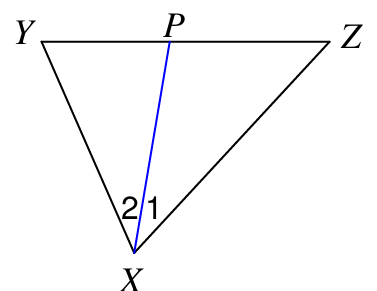
Solution :
m∠1 = m∠2
5 x − 2 = 4 x + 5
5x - 4x = 5 + 2
x = 7
So, the value of x is 7.
Problem 7 :
Find x if m∠2 = 1 + 28 x and m∠XVW = 59 x − 1.
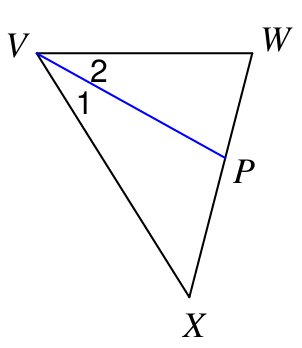
Solution :
m∠1 = m∠2
59x - 1 = 1 + 28x
59x - 28x = 1 + 1
31x = 2
x = 2/31
x = 0.06
Problem 8 :
In triangle ABC, the internal bisector AD of ∠A meets the side BC at D. If BD = 2.5 cm, AB = 5 cm and AC = 4.2 cm, then find DC.
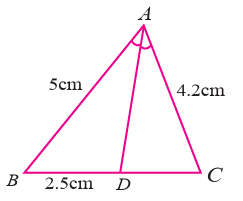
Solution :
Using angle bisector theorem,
BD/DC = AB/AC
Let DC = x
2.5/x = 5/4.2
Doing cross multiplication, we get
2.5(4.2) = 5x
x = 2.5(4.2) / 5
x = 2.1
So, the measure of DC is 2.1 cm.
Subscribe to our ▶️ YouTube channel 🔴 for the latest videos, updates, and tips.
Recent Articles
-
Finding Range of Values Inequality Problems
May 21, 24 08:51 PM
Finding Range of Values Inequality Problems -
Solving Two Step Inequality Word Problems
May 21, 24 08:51 AM
Solving Two Step Inequality Word Problems -
Exponential Function Context and Data Modeling
May 20, 24 10:45 PM
Exponential Function Context and Data Modeling